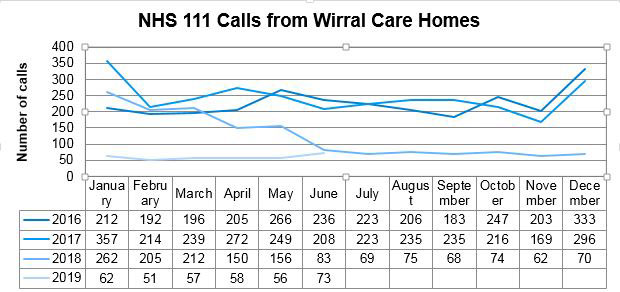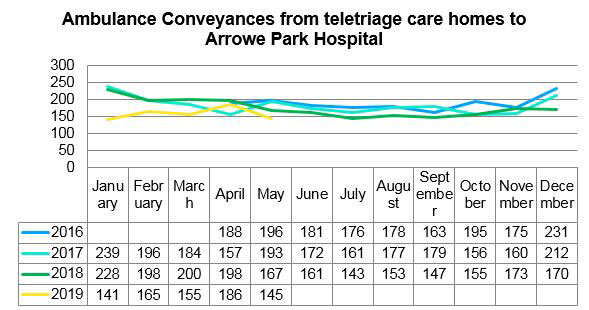Wirral has a large number of care homes and had a significant number of non-elective admissions from care home residents. It was a priority to ensure that care was provided in the patient’s place of residence wherever possible, as a non-elective admission can have a detrimental effect on frail older people. This example of a local initiative forms part of our managing transfers of care resource.
Wirral Health and Care Commissioning was looking for innovative initiatives that would, for its local care homes:
- reduce ambulance calls and conveyances
- reduce A&E attendances and admissions
- improve patient experience
- provide quicker access to clinical assessment than via NHS 111
- provide care in patient’s place of residence.
As a result, 24/7 Care Home Teletriage was developed to provide quick access to a local clinician and provide care in the patient’s place of residence.
The plan
Wirral invested in a 24/7 clinical teletriage service in 2017-18 for all older people’s residential and nursing homes in the borough. Teletriage is delivered by Wirral Community NHS Foundation Trust, with support from all partners, including Community Geriatricians, Wirral Health and Care Commissioning (local authority and clinical commissioning group), and the Innovation Agency.
Care homes have been provided with HD IPads and secure nhs.net email addresses, and staff have been trained to take basic observations and equipped with blood pressure monitors, thermometers, urine dip sticks and pulse oximeters.
Implementation
When a resident becomes unwell, care home staff use teletriage to Skype with a nurse practitioner or GP. The teletriage nurse uses the observations taken by care home staff, and a visual assessment of the patient to provide clinical advice and management without the patient needing to leave the care home. This includes advice, prescription, same day GP visit, onward referral, monitoring or supporting end of life care. Following their assessment, senior nurses coordinate the appropriate follow-up care.
Outcomes
Since its launch in 2017 the teletriage service has been rolled out across all 76 care homes in Wirral. It’s available 24 hours a day, 365 days a year, and provides faster access to a local clinician, compared to NHS 111 for care homes.
The service receives around 300 calls a month from care homes, and only 15 per cent of patients require hospital treatment following the consultation. The service has helped avoid hundreds of unnecessary hospital admissions, providing direct support to care home staff, a better outcome for patients and reduced costs to the NHS.
In terms of impact, there has been a 68 per cent reduction in NHS 111 calls from Wirral Care Homes from the 12 months prior to implementation compared to the 12 months post-implementation.
There has been a 10 per cent reduction in ambulance conveyances to A&E from care homes for 2018/19 compared to 2017/18. In addition, Winter 2018/19 did not show the usual peak in activity in December/January that has been seen in previous years.
Care home feedback
The teletriage service has been massively innovative in preventing admissions to hospital. Our staff team has grown in confidence in our ability to deal with complex situations and we are more involved in our residents care when they are in hospital as we are kept updated by the teletriage team”
Brian McNaught, Deputy Manager, Birkenhead Court Care Home.
Patient story
Patient sustained a witnessed mechanical fall resulting in a head injury. Patient was assisted into a chair and full set of observations taken. Patient had a small firm bump to the head and no other wounds or injuries. Teletriage assessed the patient, there were no red flags or indicators for CT scan as per nice guidance. Patient was given paracetamol from the care home homely remedies stock. Teletriage supplied the care home with the trust head injury advice leaflet via secure email and clear instructions for management of the patient. Teletriage staff called the home every two hours for and update and discharged the patient following six hours of supportive observation.
Next steps
Teletriage is continually working with Care Homes to ensure that residents receive high quality care in the place of their choice.
Other opportunities being explored include:
- potential to extend to other residential settings such as learning disability and mental health
- further integration with Wirral’s Single Point of Access development
- possibility of expanding Skype consultations to other services (Speech and Language, Tissue Viability)
- joint working with other agencies to deliver training to care homes on National Early Warning Score (NEWS) 2 .
Contact
Heather Harrington, Senior Commissioning Lead, Unplanned Care
Wirral Health and Care Commissioning
[email protected]


